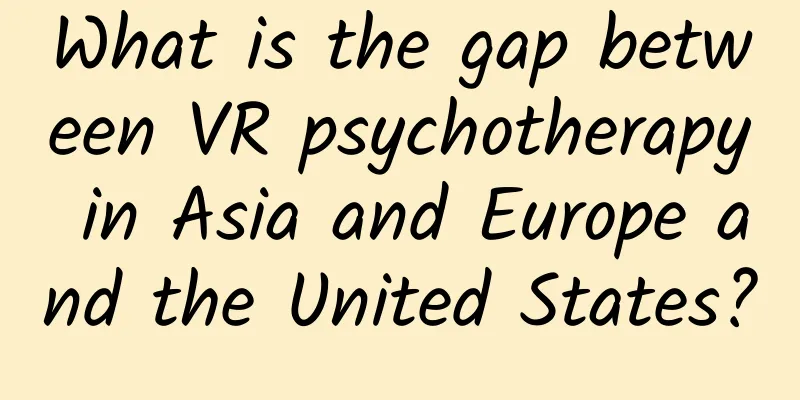What is the gap between VR psychotherapy in Asia and Europe and the United States?

|
In recent days, a news report about "a foreign guy successfully proposed marriage using a virtual reality headset" has been widely circulated. Some people commented: Who says virtual reality is useless? At least it helped others propose marriage successfully. In fact, virtual reality has great potential in many fields. Not to mention the thriving cultural and entertainment industry, or widely-regarded industry applications such as military industry, education, and medical care, the combination of VR and psychotherapy can also make technology less cold. For people with mental illness or disorders, they are unwilling to face the reality experience. Virtual reality can build a bridge between psychologists and patients in psychotherapy, so that psychotherapy can be better carried out with the help of virtual reality. 1. In what areas of psychotherapy is VR specifically used? Psychological consultant Qiao Miao told us: An avatar (virtual person) in virtual reality is a sub-personality in the individual's psychological reality. Virtual reality technology gives us the opportunity to consciously play the sub-personality, or even to create a sub-personality first and then play it. In turn, it is natural that this sub-personality affects our thoughts and behavior patterns in real life. In terms of psychotherapy, VR technology is well-known for its ability to treat phobias, PTSD, etc., and its application areas have been continuously expanded in recent years. Leifeng.com has conducted a comprehensive search of VR psychotherapy abroad and made a small summary (no thanks, please call me Leifeng). This time, in terms of VR psychotherapy, Asia has really widened the gap with Europe and the United States. Self-Acceptance Psychologists and computer scientists from University College London (UCL), the University of Barcelona in Spain, and the University of Derby in the UK have published a study proposing a new psychotherapy approach that could enhance self-compassion – using virtual reality technology. The specific case is called the "avatar experiment". During the experiment, the subjects will be avatars for the comforter, the comforted, and the third person perspective. The results show that women who look back on the comfort process from the perspective of a virtual child will become more self-compassionate; at the same time, their level of self-criticism will be significantly reduced. Women who look back on the comfort process from a third-person perspective will also reduce self-criticism, but rarely improve in self-compassion. Anxiety disorders The treatment process achieved through virtual reality technology is that when the patient is diagnosed with psychological anxiety, he will be taken to a room equipped with virtual reality equipment, and either communicate with virtual people (eat, chat), or let him sit in a very comfortable chair, turn on the equipment, and let the patient feel that he has entered a new and peaceful environment, such as the seaside. If the patient's anxiety level is relatively high and he cannot feel relieved just by immersing himself in the scenery, he needs the guidance of a psychologist. The psychologist's professional knowledge can be used to transmit voice information to the patient through virtual reality equipment, which, combined with the immersive environment, can achieve a better therapeutic effect on the psychological anxiety. Phobia Putting people in situations where they are anxious enables them to face their real-world fears later in life, such as fear of heights, flying, animals (such as spiders), driving, claustrophobia, public speaking, etc. Sexual dysfunction A research team in Montreal, Canada, has developed a virtual reality system that can be used to test and evaluate whether psychological treatment for sexual offenders is effective. Usually, accused sexual offenders are required to undergo psychological treatment and are allowed to be released back into public places after being evaluated. (It may also include "VR shameful things" treatment direction?) Post-traumatic stress disorder For some veterans who have experienced war, virtual reality helmets can be used to treat severe post-traumatic stress disorder. (It is also applicable to other types of post-traumatic stress disorder, the principle is the same) At a certain moment, patients should retrieve the memories stored deep in their minds and re-examine and process them. Only in this way can they get out of the shadow of trauma. This is the theoretical basis for using virtual reality equipment for psychological treatment. In addition, virtual reality is also used in the treatment of anorexia, attention deficit disorder diagnosis, schizophrenia and other mental illnesses. 2. How is VR psychotherapy different from traditional therapy? The biggest difference between VR and other treatment methods is the sense of presence The subjective experience of being in a certain place or environment obtained by an individual through automatic or controlled psychological processing, and this environment is not necessarily the actual physical environment in which the individual is located. (High energy ahead, this article is full of similar textual expressions) A scholar from the Department of Psychology of East China Normal University said so. He told us that traditional psychotherapy techniques such as psychoanalysis, behavioral therapy, cognitive therapy, family therapy, etc., all require guiding patients to recall and imagine during the treatment process, which creates a connection point for VR technology to assist traditional psychotherapy. Effectively enhance the client's sense of self-efficacy Because VR technology safely and effectively helps clients focus on behavior, experience different selves, and challenge existing assumptions, the use of VR technology in psychotherapy can effectively support clients and enhance their sense of self-efficacy in and outside of the consultation situation. When applying VR technology, counselors do not have to change their usual treatment methods when facing different clients. For example, behavioral therapy can use VR scenarios to activate the client's fear; cognitive therapy can use VR scenarios to evaluate situational memory or disintegrate habitual selective attention patterns; experiential therapy can use VR technology to isolate the client from the outside world and help him or her practice correct behavior. Psychodynamic therapy can use VR environments as complex symbol systems to evoke or release emotions. Why haven’t we experienced VR psychotherapy yet? The selection of VR psychotherapy topics is extremely difficult. There are two main types of people doing this in China: one is psychology research institutions, which want to try the latest VR treatment methods; the other is VR laboratories, which want to explore the topic of psychotherapy. The common feature of the two is that most of them come from universities, and private institutions are rarely interested; the two also have one thing in common, that is, they don’t seem to know each other, the information between disciplines has not yet been connected, and they are still operating independently and struggling. In fact, scientific research funds are extremely limited. An expert in the computer field and a well-known psychologist in China respectively told Leifeng.com about VR psychotherapy. Specifically, the current difficulties of VR psychotherapy are: 1. The development of virtual reality psychotherapy software, due to its strong targeting, often makes the patient group of treatment relatively single and cannot be applied on a large scale; 2. Cultural differences in virtual reality psychotherapy should be taken seriously. Some non-verbal cues in virtual environments can cause misunderstandings among people from other cultures. 3. At present, the equipment and software of VR technology lack standardization, the treatment agreement lacks standards, the virtual environment provided is small and the R&D cost is high, all of which will restrict the development of VR psychotherapy; 4. What is the most expensive thing in the 21st century? Talent. The clinical skills of the counselor are still the key to the successful application of VR technology in psychotherapy. For psychological research, virtual reality is just a technology or method. Similar to psychological statistics, if the tool is used instead of the research problem itself, it will lead to a contradiction between the perfect performance of statistical form and the low actual utility. In a word, the cost is high, and the industry application and commercial monetization are unclear. So, in what areas is VR psychotherapy likely to be widely used? An industry insider told us that "promoting corporate culture" (no words to say here) and "training psychological counselors" may be two breakthroughs. Currently, the training methods for psychological counselors are relatively traditional and inefficient. From counseling novices to experienced therapists, their growth relies on attending lectures, role-playing with classmates, watching clinical psychotherapy videos, and clinical practice under supervision. The common shortcomings of all these training methods are: lack of multi-sensory target objects, no clearly articulated assessment procedures, and no environment that can produce continuous stimulation to help the instructor accurately evaluate the performance of the trainees. These deficiencies put novice counselors at a disadvantage when they first encounter clients with suicidal or murderous risks, because in their previous training, they have no chance to experience how to actually deal with some patients with more serious mental disorders and clients in psychological crisis, which is exactly where VR technology comes in handy. As a winner of Toutiao's Qingyun Plan and Baijiahao's Bai+ Plan, the 2019 Baidu Digital Author of the Year, the Baijiahao's Most Popular Author in the Technology Field, the 2019 Sogou Technology and Culture Author, and the 2021 Baijiahao Quarterly Influential Creator, he has won many awards, including the 2013 Sohu Best Industry Media Person, the 2015 China New Media Entrepreneurship Competition Beijing Third Place, the 2015 Guangmang Experience Award, the 2015 China New Media Entrepreneurship Competition Finals Third Place, and the 2018 Baidu Dynamic Annual Powerful Celebrity. |
<<: Virtual Reality to Reach $30 Billion by 2020
>>: Is "Internet+" the isatis root of China's economy?
Recommend
CTR: Panoramic insights into the digitalization of car life in 2022
Research background and definition of car life di...
Does the alien world sound a bit scary? China's Sky Eye detects new phenomenon of "Black Widow" pulsar
Recently, the "China Sky Eye" observed ...
Zhuorang Xianyu Xiaobai five-day training camp, one hour a day, make money easily and faster [video course]
Zhuorang Xianyu Xiaobai five-day training camp, o...
China Passenger Car Association: Regional market analysis of new energy passenger vehicles in May 2022
According to the new energy vehicle retail data o...
Attention! WeChat suspends new user registration for personal accounts: resume in early August
Today, there was news online that "WeChat ha...
Increase speed and reduce fees? The three major operators are playing tricks together
[[134373]] A month has passed since the Prime Min...
What! Can we see the Northern Lights in the country?
I believe everyone has seen photographs of the au...
How to plan a marketing event with zero budget and that goes viral? !
As a marketing dog, you must have the moment when...
Foreign trade Google optimization, how to optimize foreign trade websites for Google SEO?
Foreign trade Google optimization, how to conduct...
What are the costs for developing a mall mini program?
1. Free store opening with mini programs: Most ma...
Grain Rain is coming: the last solar term of spring, what is its connection with rainfall?
Before we know it, the Grain Rain solar term is a...
Xiaohongshu product analysis report!
Xiaohongshu is known as a popular shopping tool f...
Learn character design with Hollywood animation masters 2020 [good quality]
Learn character design with Hollywood animation m...
The current appearance of these cultural relics | Don’t say that the Three Gorges are dangerous, they are safe every year
In the past, when people talked about the Three G...









